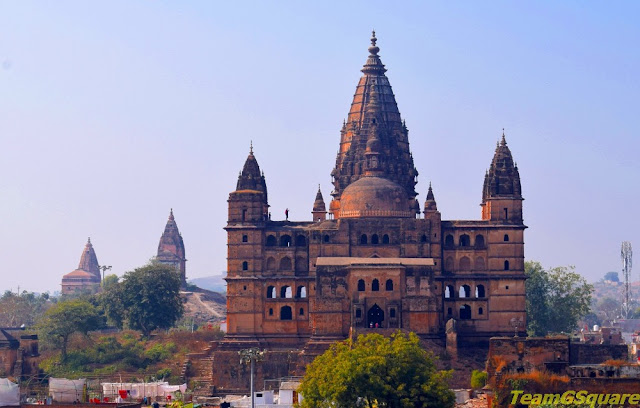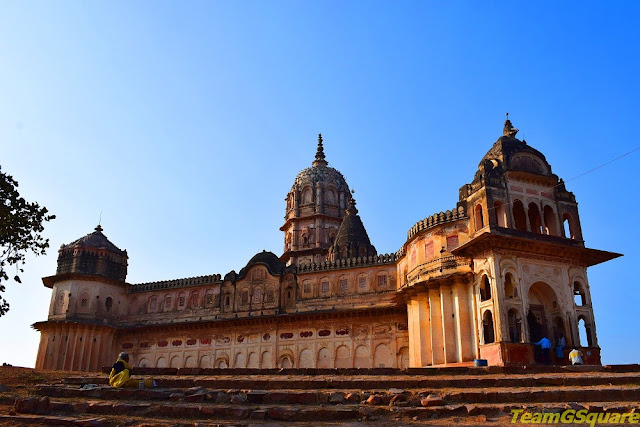 |
| Orchha - The Land of Palaces and Temples |
We had to drop our plan of
visiting Naresar as it was late in the evening and already dark. We bade goodbye to
Bateshwar and moved ahead towards our next destination of Orchha. A long drive of
about 3 hours during a winter evening in the northern part of Madhya Pradesh
was quite challenging! We reached Orchha and zeroed in on a hotel to rest for
the night.
Orchha seemed very calm and quiet
during the night and we were pretty sure of an exciting day ahead. We woke up
to chilly morning and had to wait for quite some time for the fog to clear off
to start exploring Orchha. Orchha is a small historical town situated on the
banks of river Betwa and is about 130 km from
Gwalior.
 |
| Good Morning Orchha |
 |
| Chaturbhuj Temple Engulfed by Fog |
Orchha was the capital city of
Bundela Rajputs and was founded by Maharaja Rudra Pratap in 1531 AD. The
Bundelas migrated from Varanasi to Garh Kurar and then to Orchha and were considered
to be great builders, strong warriors and patrons of art. The Bundelas had to
deal with Mughals who were in great command especially in the mainland region
of India. Sometimes they fought against the Mughals, and sometimes they expressed
great friendship with them, and such behavior always ensured that the Mughals were
constantly alert and vigilant. The histories
of the opposition towards Mughals by Champartai, his son Chhatrasai, Diman
Hardaul, Vir Singh Deo and others deserves mention and have been successful at
times in keeping the opposition at bay. The Bundelas kings were great builders
with remarkable acumen and foresight. Among
the Bundelas, Vir Singh Deo built the maximum number of temples and is
considered to be the best among them. The temples built by them today stand as
a testimony to the skill they possessed and their devotion towards religion.
The legends of Rani Ganesh Kunwari and Madhukar Shah, and Hardaul to this day
are impregnated in the walls of Orchha and capture every traveler’s
imagination. In this post we make an attempt to list all the temples we visited
here.
 |
| Chaturbhuj Temple as Viewed from Raja Mahal |
Chaturbhuj Temple: Chaturbhuj temple is one among the grandest
temples built in India post 16th century when the Mughals were
ruling the larger part of India. This temple was initially built to house the
murti of Lord Rama that Rani Ganesh Kunwari bought from Ayodhya, but Lord Rama
remained in Rama Raja Temple. This temple stands on a huge stone platform and currently
houses murtis of Radha and Krishna.
 |
| The Mighty Chaturbhuj Temple |
 |
| Chaturbhuj Temple |
Rama Raja Temple: This could be the only temple where Lord Rama is worshiped as a King and not as a god, and also can be considered to be one among
the unusual temples of India. This palace turned temple has an interesting
legend associated with it. It is the most lively temple in this historical town
and is a must visit to every tourist visiting Orchha.
 |
| Rama Raja Temple |
Shiva Temple: This temple is dedicated to Lord Shiva and may have
been built during the 17th century on the basis of its architecture
features. The temple is located outside the fort complex near the river Betwa. The
Shivalinga and the images of Shiva have been shifted to Rama Raja temple.
 |
| Shiva Temple |
Vanvasi Rama Mandir: This temple is dedicated to Lord Rama and was
constructed during the reign of Maharaja Vir Singh. Like that of the Shiva
temple, murti of Lord Rama has been shifted to Rama Raja temple. The Shikara of
this temple is of Bhumija style of temple architecture.
 |
| Vanvasi Rama Mandir |
Radhika Vihari Temple: This temple is dedicated to Radhika Vihari and
was constructed during the reign of Maharaja Vir Singh. The Garbhagriha of this
temple has panchrathi projections and a spire decorated with urushringas (subsidiary
towers) of
Khajuraho Style. This beautiful temple is the one of the best
specimens of Bundela architecture.
 |
| Radhika Vihari Temple |
Panchmukhi Mahadeva Mandir: This temple is located inside a fortified
square courtyard. This temple also can be dated to 17th century AD
based on its architectural features. The temple architecture is representative
of the Astabhadra (octagonal) plan of Bhumija style of Architecture. The other temple in this complex is of a similar
plan, but of a smaller size.
 |
| Panchmukhi Mahadeva Mandir |
Lakshmi Temple: This beautiful temple is rectangular in plan and was
built by Vir Singh in 1622 AD. The inner walls and hemispherical ceilings
of this temple are profusely decorated with paintings depicting lives of the
kings and queens and stories from the epics of Ramayana and Bhagavad Gita.
 |
| The Grand Lakshmi Temple |
 |
| Krishna and Gopikas |
 |
| Beautifully Decked Up Wall of Lakshmi Temple |
To be continued…
Related Posts:


























